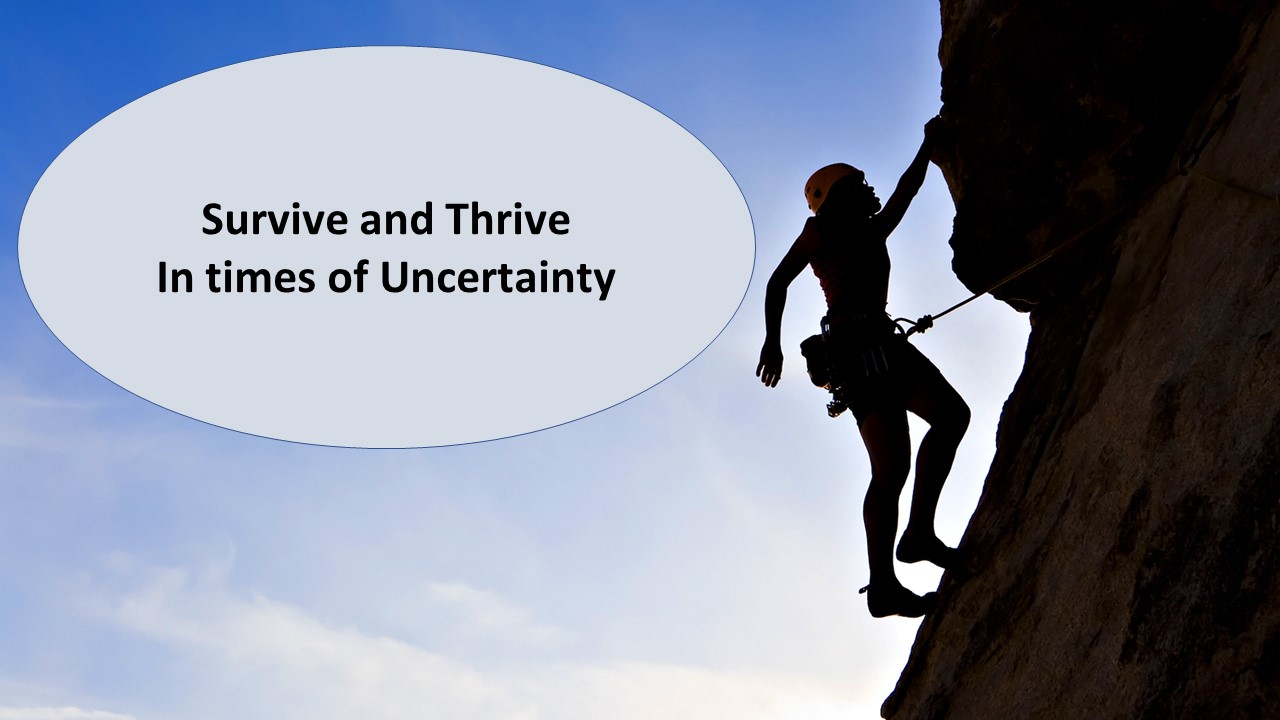By Thomas Davis, CRNA, MAE, Lt. Col (ret)
Follow @procrnatom on Twitter
“life is uncertain, eat dessert first”
Jim, the auto salesman, is dependent upon commission and never knows from month to month just how much money he will take home; Jim lives his life with worry about whether or not bills will be paid. Fred, an OR nurse, works in a hospital where the number of surgical cases is dwindling, and he constantly worries about the dreaded lay-off. Amanda, a Nurse Anesthetist, has just heard an unverified rumor that her group is in the process of being taken over by a larger anesthesia management company; Amanda fears that her pay and benefits will be reduced or that her job will be eliminated. Francis is a parent and watches anxiously as her daughter leaves on her first date.
Living in world in which uncertainty is the norm causes many people to be distressed as evidenced by behavior that clearly driven by fear and anxiety. In contrast to the safety and security that accompany stability, an aura of unpredictability arises from a situation in which the facts have yet to emerge. Fear of the unknown results in subjective speculation that may leave some people feeling weak and vulnerable. For those who worry about becoming victims, the mind quickly imagines doom and gloom scenarios that always end poorly; however, for others, uncertainty is linked to change offering an opportunity to alter of the status quo and thrive in the process.
Those who prosper and grow during times of uncertainty have learned to implement design thinking when faced with ambiguous situations. Writing in Interaction Design foundation, authors Dam and Saing describe design thinking as. “…an iterative process in which we seek to understand the user, challenge assumptions, and redefine problems in an attempt to identify alternative strategies and solutions that might not be instantly apparent with our initial level of understanding.” To implement design thinking, the individual must first investigate to uncover facts that are available rather than jumping to conclusions based on partial or faulty information, and then remain positive while visualizing a variety of potential outcomes.
Abandoning the natural tendency to link fear with uncertainty transforming to the development of a mindset that produces a better outcome is not difficult; however, it does require conscious effort. In order to thrive while others are struggling to survive uncertainty, use the following habits to design a plan that works for you.
Control your Amygdala
The first step in flourishing during uncertain times is to quiet the emotional brain. The amygdala is the area of the brain linked with fight, flight, or freeze and kicks in quickly during times of stress. Once the amygdala is activated, stress hormones are released, and the emotional centers of your brain scream so loudly that the thinking brain is silenced (the amygdala hijack). Be aware when you are stressed and rather than succumbing to a knee jerk, emotive response, challenge your thinking brain by assuming that the facts are not yet known and seek more information
Name your feelings
When apprehension produces anxiety, take a moment to explore your feelings and how they are connected to your stress. Name the emotion you are feeling – fear, anger, genuine concern – then ask yourself if the facts that are known justify your emotional response. Determine other emotions that could be warranted if the initial information is not completely true and don’t forget to consider positive emotions such as joy, satisfaction or fulfillment. By considering other emotions, you are also acknowledging that other outcomes may arise from the uncertainty.
Choose your response
After you’ve gathered information, acknowledged how you feel and identified a variety of outcomes that could emerge from the uncertainty at hand, use the facts, your personal goals and the available resources to develop a response that will promote your best interest. When the outcome involves a group, make an effort to quiet the emotions of those around you and enlist them as allies in your plan to create the best possible outcome under existing circumstances.
Develop a contingency plan
Despite your best effort, some situations really are as bad or worse than the rumors and it’s time for plan B. which may involve moving on. Developing a contingency plan has two advantages; it gives you a sense of being in control and it provides an alternative outcome. Often, implementing a contingency plan and seeking employment elsewhere allows you to thrive in ways that were never possible in your current position. Uncertainty can be a mixed blessing and force your hand in making a necessary decision.
Uncertainty is a certainty in one’s life both on and off the job. We can never predict changes that will be thrown our way. However, we can develop personal skills and design our own plan that will enable us to not only to survive, but to thrive. Whether you are selling cars, putting patients to sleep or staying awake til your daughter gets home from her first date, take control and turn ambiguity to advantage.
Thomas Davis is a noted leader, educator, speaker and clinical anesthetist.
Join a group of your healthcare colleagues in the on-line leadership journal club at 7:30 Central time the second Tuesday of each month. Click here for more information.
